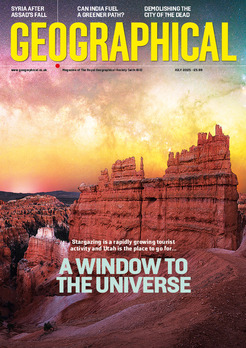
South African born ‘struggle photographer’ Gideon Mendel hauntingly captures the aftermath of fires and floods around the world
It began as a way to talk about climate change and the climate emergency. I was thinking about how climate change will affect the lives of my children. It emerged out of a mental exercise, imagining the world that my two young kids would be living in when they were my age. But as I think we’re all aware, it’s happening much sooner than expected.’
South African-born photographer Gideon Mendel is telling me about his latest exhibition, Fire/Flood, which is currently on show at the Photographers’ Gallery in London. The exhibition brings together of two of Mendel’s projects: Drowning World and Burning World, which document the aftermath of floods and fires around the globe.
The flood work began in 2007. ‘I have to work pretty slowly – it has been an incremental process, getting to floods whenever I can,’ Mendel explains. The fire work began more recently. ‘In 2018, I was in California for an exhibition and I went with a friend to make some photographs in the aftermath of the Carr fire, but I wasn’t happy with the results. Then, at the start of 2020, when the huge fires were burning in Australia, I started to try again, and I think I managed to figure out my visual approach.

‘In a flood scenario, you have a plane of flat water in front of you, this very even, clean plane, which makes it visually much easier,’ he continues. ‘The hard thing is to be there – the logistical challenge of being there with your cameras and, obviously, it’s a situation of huge tragedy and huge calamity for people – but the light, the colour, the reflections, everything about it makes for something that’s visually astonishing.
‘When it came to photographing fire, I made the decision early on that I didn’t want to be chasing the burning fires. Obviously, burning fires are visually very rich, but it’s a difficult situation to be engaging with people, trying to get people’s attention, because obviously, most people are fleeing a fire. I also don’t want to be in the way of an emergency response to a fire. So I made the decision to be making the work I do in the aftermath.’

Mendel made his name as a ‘struggle photographer’ in his native South Africa, documenting the brutality of life under apartheid during the 1980s. In the early 1990s, he moved to the UK and began a long-term project documenting the impact of HIV and AIDS . ‘I’ve always been drawn to the key social issues of our time,’ he says. ‘In my work on HIV, I really identified with the struggle to bring HIV treatments to Africa and parts of the world that couldn’t afford them. There was a terrifying global divide where people with HIV and AIDS in the West could access life-saving treatment and people in Africa couldn’t. That global activism had a remarkable impact; it really changed things.
‘Coming to climate change, I can see that photography is a small voice, it’s quite limited,’ he continues. ‘So it makes sense if it’s aligned with organisations, with people, who are trying to make a difference. Recently, I exhibited my work with Greenpeace at Glastonbury. I’m really interested in bringing my work out of a conventional gallery context and into wider public contexts, creating hybrid art–activist installations, bringing messaging into surprising places.’
This idea of bringing the message to the people has informed Mendel’s most recent project, in which has been working with an art facilitator and a group of eight- and nine-year-old students at a local school, getting the kids to draw their own versions of his flooding and fire portraits. ‘A whole wall of the dining room at the school is going to be taken over by the installation,’ he says. ‘It’s taking the work to a new level for me.’
Fire/Flood is on show in the outdoor Soho Photography Quarter at the Photographers’ Gallery until 31 October. Entry is free. www.gideonmendel.com






What Gideon says…
…on his purpose
I like to open people’s eyes. I like to tell stories and to make real what you often see as statistics. I’m translating and transmitting the message to the world. It’s something very visceral, but it isn’t about victimhood. I want my subjects to have a kind of agency and autonomy.
…on his inspiration
I was very inspired by David Goldblatt, who was a very generous mentor to me at the beginning of my career. And I’ve always been drawn to activists who’ve put activism out in the streets – people who’ve taken huge personal risks to try to save us all.
…on his advice
Six words: read, read, read; look, look, look. I’m often surprised by how little young, emerging photographers know about other photographers – what’s been done. So, I would say, read a lot, but also go to libraries, look at books. I’m sorry I didn’t do more of it early in my career.




